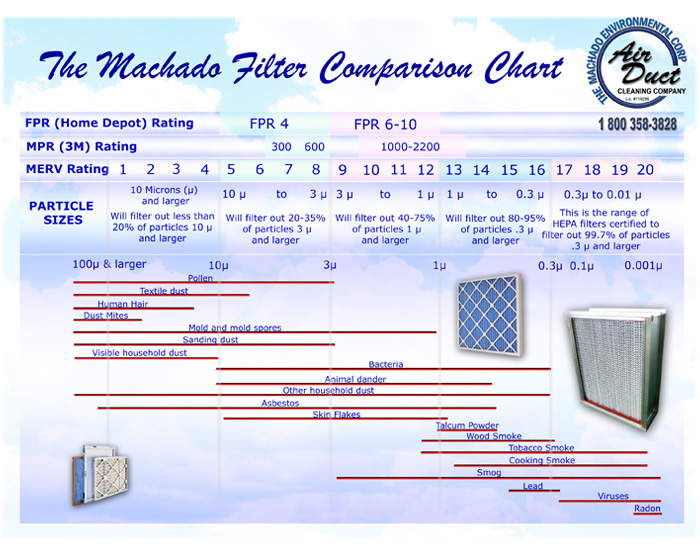
More Articles
Choosing the right filter—easy right? Maybe.
You would think the subject of filters for your heating and air system would be simple. All you want is to get rid of the dust and dirt from the air that goes through your system.
But when you go to the local hardware store, you are faced with a wall of air filters ranging from a couple of bucks each to $20-30, all claiming to filter everything out of the air. Suddenly, it isn’t so simple. What do you do?
There are a half dozen different rating systems for furnace filters: hypoallergenic filters marketed to those with allergies or sensitivities, ultra-allergenic filters, electrostatically charged filters, carbon filters, MERV ratings, Dust Spot Efficiencies and all sorts of other buzzwords and marketing phrases that do little more than confusing the issue. All the filter labels say that this filter will remove all the nasty things from the air.
There are a great number of factors that are taken into account when determining the effectiveness of a filter, including the size of particles being filtered, the resistance of the filter material to the air flow, the velocity of the airflow, what the long term efficiency is of the filter as opposed to the startup efficiency. It gets rather involved.
But does a consumer actually have to know all those details? We don’t think so, and frankly, neither does ASHRAE (American Society of Heating, Refrigerating and Air Conditioning Engineers).
In an attempt to standardize the measurement of filter efficiency, ASHRAE developed a measuring system called the “MERV” system (Minimum Efficiency Reporting Value) which takes into account many of the above variables so that filter manufacturers and consumers alike can compare one filter to another. Unfortunately, things are not in sync yet, and there are different interpretations of the MERV Rating system. Some manufacturers have come up with their own rating systems and in an effort to out-market the competition, the manufacturers have invented their own buzzwords.
For example, a certain filter manufacturer’s promotion says their filter is “98% efficient”. 98% of what? And what about the other 2%? That is a completely meaningless statement. Here is something we feel might be of help. A chart we put together to show what the various MERV ratings will generally filter out of the air and how those levels coincide with other “rating” systems.
To give a little more explanation of relative sizes of particles and what they mean, here is some information on airborne particles. It is the airborne particles that are of concern. If it is on your desk, dresser or table, it is not in your lungs. Airborne particles are solids suspended in the air.
Larger particles - larger than 100 μm (micrometers)
- fall out quickly and don’t remain suspended in the air.
- includes hail, snow, insect debris, visible room dust, soot aggregates, coarse sand, gravel, and sea spray, most ash, grit.
Medium-size particles - in the range 1 to 100 μm
- settles out slowly but does settle.
- includes fine ice crystals, pollen, hair, skin dander, large bacteria, windblown dust, fly ash, coal dust, silt, fine sand, talc, and small dust.
Small particles - smaller than 1 μm
- falls slowly, takes days or even longer to settle out of a quiet atmosphere. In a turbulent atmosphere, they may never settle out.
- can be washed out by water or rain
- includes viruses, small bacteria, metallurgical fumes, soot, oil smoke, tobacco smoke, asbestos, clay, and fumes (smog)
In this order of importance, the most important things about the filters for the air conditioning systems:
- There is a slot or compartment in which to put a filter.
- There is actually a filter in the slot and it is changed regularly (every 3-4 months).
- The filter fits properly - there are no gaps around it.
- And finally, what is the level of efficiency of the filter.
The efficiency of the filter can be generally determined by the above (attached) chart. We recommend a filter of at least MERV 7 or 8, which is the most commonly available grade of a filter. Do not use the $.95 flat panel fiberglass filters which are less than MERV 4. They might stop leaves, big bugs or small Volkswagens, but will do little to protect the A/C equipment or your lungs. Spending a little more money will get you a MERV 11-12 filter which filters a high percentage of the particles you want out of the air.
Trying to find a higher MERV filter than that will involve either more sophisticated filter systems than single 1-2” pleated filters or more powerful equipment to overcome the resistance to the air flow. You could have the most expensive and efficient residential filter made, but if it is sitting on the floor next the furnace or there is a big gap on the side because it doesn’t fit properly or it is collapsed because it hasn’t been changed in two years, you might as well save your money and simply call us to clean your air system annually. Or, you can make sure the above four points are fully in and only call us every 5-10 years. It’s up to you.








